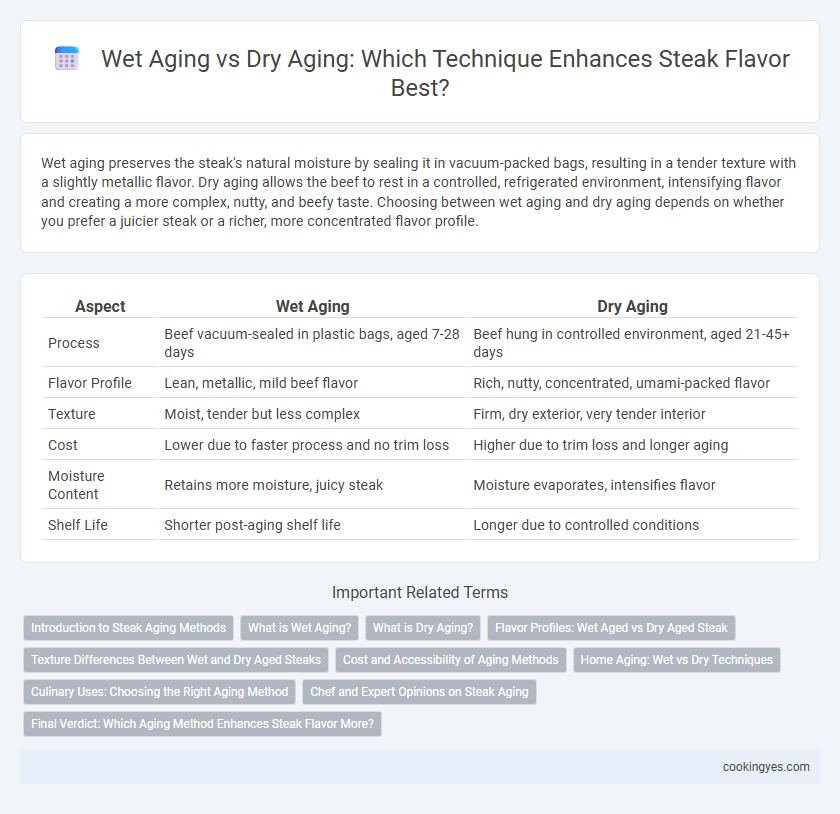Wet aging preserves the steak's natural moisture by sealing it in vacuum-packed bags, resulting in a tender texture with a slightly metallic flavor. Dry aging allows the beef to rest in a controlled, refrigerated environment, intensifying flavor and creating a more complex, nutty, and beefy taste. Choosing between wet aging and dry aging depends on whether you prefer a juicier steak or a richer, more concentrated flavor profile.
Table of Comparison
| Aspect | Wet Aging | Dry Aging |
|---|---|---|
| Process | Beef vacuum-sealed in plastic bags, aged 7-28 days | Beef hung in controlled environment, aged 21-45+ days |
| Flavor Profile | Lean, metallic, mild beef flavor | Rich, nutty, concentrated, umami-packed flavor |
| Texture | Moist, tender but less complex | Firm, dry exterior, very tender interior |
| Cost | Lower due to faster process and no trim loss | Higher due to trim loss and longer aging |
| Moisture Content | Retains more moisture, juicy steak | Moisture evaporates, intensifies flavor |
| Shelf Life | Shorter post-aging shelf life | Longer due to controlled conditions |
Introduction to Steak Aging Methods
Steak aging methods, primarily wet aging and dry aging, significantly influence the meat's flavor and tenderness by allowing natural enzymatic breakdown. Wet aging involves vacuum-sealing beef to retain moisture, resulting in a juicier but milder flavor, while dry aging exposes the meat to controlled air conditions, intensifying its beefy taste and creating a firmer texture. Understanding these aging processes helps steak enthusiasts and chefs select the optimal method for desired flavor profiles and culinary outcomes.
What is Wet Aging?
Wet aging is a process where beef is vacuum-sealed in plastic and aged under refrigerated conditions for weeks, allowing natural enzymes to tenderize the meat while retaining moisture. This method enhances the steak's juiciness and delivers a fresher, more metallic flavor compared to dry aging. Wet aging is commonly used in the meat industry due to its cost-effectiveness and minimal weight loss during the aging period.
What is Dry Aging?
Dry aging is a process where whole beef cuts are stored in a controlled, refrigerated environment with precise temperature and humidity levels, allowing natural enzymes to break down muscle tissue and intensify flavor. This method typically lasts from 14 to 60 days, enhancing tenderness and imparting a distinctive nutty, earthy taste. The controlled exposure to air also results in a concentrated, richer flavor profile compared to wet aging.
Flavor Profiles: Wet Aged vs Dry Aged Steak
Dry-aged steak boasts a concentrated, nutty flavor with earthy undertones and a firm texture resulting from moisture evaporation over weeks. Wet-aged steak, stored in vacuum-sealed bags, retains a more tender, juicy profile with a slightly metallic or bloody taste due to enzymatic breakdown in a high-moisture environment. The choice between wet aging and dry aging directly impacts the steak's complexity, richness, and mouthfeel, influencing gourmet culinary experiences.
Texture Differences Between Wet and Dry Aged Steaks
Wet aging preserves juiciness by aging steak in vacuum-sealed bags, resulting in a tender texture but with a somewhat softer, less complex bite. Dry aging exposes steak to air in controlled environments, causing moisture loss that concentrates flavor and creates a firmer, chewier texture with a distinctive crust. The choice between wet and dry aging significantly impacts the steak's texture, with wet-aged cuts offering a more supple mouthfeel and dry-aged steaks providing a robust, textured chew.
Cost and Accessibility of Aging Methods
Wet aging is typically more cost-effective and accessible due to its reliance on vacuum-sealed packaging and refrigerated storage, making it the preferred choice for many commercial operations. Dry aging requires specialized temperature- and humidity-controlled environments, increasing both setup and maintenance costs, which limits its use primarily to high-end steakhouses and boutique butchers. The higher price point of dry-aged beef reflects these expenses, alongside its distinct, concentrated flavor profile valued by connoisseurs.
Home Aging: Wet vs Dry Techniques
Wet aging preserves steak moisture by vacuum-sealing the meat, enhancing tenderness through enzymatic breakdown while maintaining a milder flavor profile. Dry aging involves hanging the steak in a controlled, refrigerated environment with specific humidity levels, intensifying the beef's flavor and developing a firmer texture by allowing natural enzymatic and microbial processes. Home aging with wet techniques requires minimal equipment and reduces spoilage risk, whereas dry aging demands precise temperature and humidity control to prevent bacterial growth and achieve optimal flavor concentration.
Culinary Uses: Choosing the Right Aging Method
Wet aging preserves moisture and results in a tender, juicy steak ideal for recipes requiring a milder beef flavor, such as stir-fries and grilled cuts. Dry aging concentrates flavor and enhances umami through moisture evaporation, making it preferred for premium steaks and dishes where a robust, complex taste is desired. Chefs select wet aging for versatility and cost-efficiency, while dry aging suits gourmet preparations demanding intense flavor development.
Chef and Expert Opinions on Steak Aging
Chef and expert opinions on steak aging emphasize that dry aging enhances flavor complexity by concentrating natural enzymes and intensifying beef umami, resulting in richer, nuttier, and more robust taste profiles favored by culinary professionals. Wet aging preserves juiciness and tenderness due to vacuum-sealed packaging but often yields a milder flavor compared to dry-aged cuts, making it popular in commercial kitchens prioritizing consistency and volume. Industry experts highlight that dry aging requires precise environmental control and time investment, which justifies its premium price and appeal among high-end steakhouses seeking to deliver exceptional flavor depth.
Final Verdict: Which Aging Method Enhances Steak Flavor More?
Dry aging enhances steak flavor more profoundly by intensifying umami notes and creating a tender texture through natural enzymatic breakdown and moisture evaporation. Wet aging, while preserving juiciness and resulting in a more metallic, less complex flavor, lacks the depth and richness developed during the dry aging process. For flavor enthusiasts seeking a robust, concentrated beef character, dry aging remains the superior method.
Wet Aging vs Dry Aging for steak flavor Infographic

 cookingyes.com
cookingyes.com